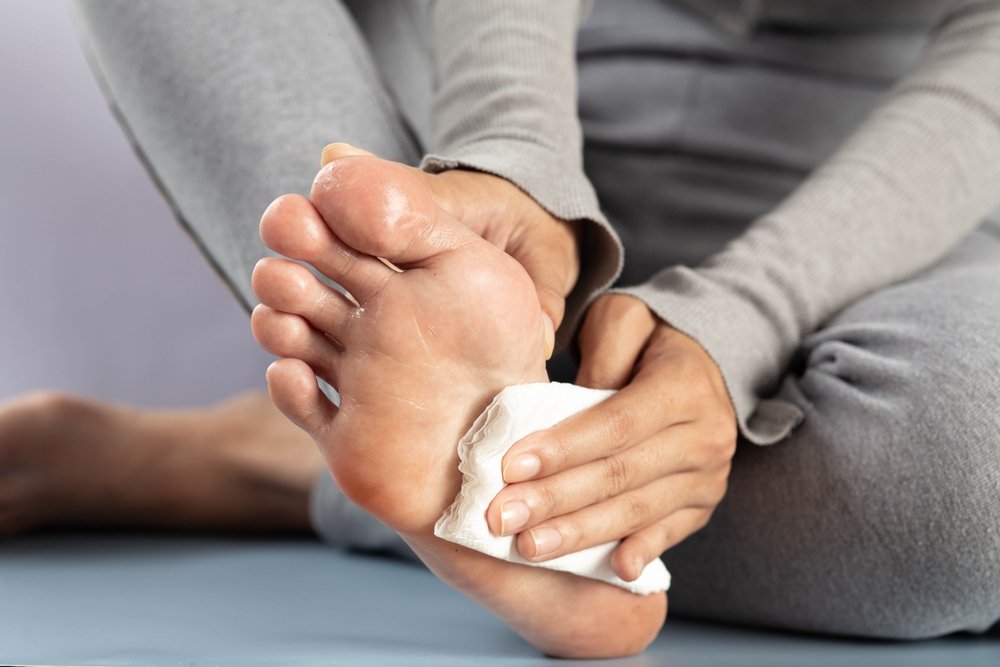-
Excessive sweating of the feet is called hyperhidrosis. It's more common in men than in women, and more common in young adults than older adults.
People whose feet sweat excessively often also have problems with excessive sweating of the palms. According to the International Hyperhidrosis Society, 3 percent of the population suffers from hyperhidrosis.
-
Excessive sweating of the feet seems to be an inherited problem. No one knows exactly why it occurs, but people who sweat excessively seem to have a different “set point” than other people. Most people sweat when it's hot out, or when they become warm. People with hyperhidrosis sweat excessively almost all the time.
-
The most obvious symptom of hyperhidrosis is feet that sweat excessively. Some people sweat so much that their feet may slip around inside their shoes.
The feet may also have a whitish, wet appearance; sometimes, foot infections are present as well. (Constant wetness breaks down the skin, allowing infection to set in.) Foot odor is common.
Those suffering from hyperhidrosis may also experience emotional stress and worry regarding foot odor. Sweat-related anxiety and isolation can be particularly severe among teens with plantar hyperhidrosis.
-
Good foot hygiene is essential. Wash your feet daily with an antibacterial soap; be sure to wash between the toes. Dry the feet thoroughly, then apply cornstarch, foot powder, or an antifungal powder to your feet. Wear wicking socks made of natural or acrylic fiber blends that draw the moisture away from your feet instead of trapping it. Some synthetic blends are designed to wick moisture away from the skin and work best to keep the feet dry. One hundred percent cotton socks absorb moisture but do not wick it away from the skin and frequently lead to blisters, so they should be avoided.
It's also a good idea to change socks during the day. Stash an extra pair of socks at school or at work, and change socks mid-way through the day. Wear shoes that are made of breathable materials.
A technique called iontophoresis, which uses water to conduct a mild electrical current through the skin, has been found helpful for people with sweaty feet. People can purchase iontophoresis machines for at-home use.
-
If your feet sweat excessively, see a podiatrist. According to the US National Library of Medicine, less than 40 percent of people with excessive sweating seek medical care. A podiatrist can help you control this embarrassing condition. Patients who talk to their podiatrists about plantar excessive sweating may also have concerns regarding extreme sweating elsewhere: such as in their underarms, on their palms, or on their face or scalp.
-
Most often, excessive sweating of the feet is diagnosed based on your reporting of symptoms and a physical exam of the feet. A podiatrist can also do a starch-iodine test to confirm the diagnosis. First, an iodine solution is applied to the bottom of the feet. After the solution has dried, cornstarch is sprinkled over the area. The treated area turns dark blue if excessive sweat is present.
Treatment options are tailored to your symptoms. Over-the-counter or prescription roll-on antiperspirants may be applied directly to the feet. Botox injections can temporarily control excessive sweating of the feet. (The effect generally lasts for about six to nine months.) Oral prescription medications, often anticholinergics, can be used. Severe cases of sweaty feet may be treated with a surgical procedure called a sympathectomy, which interrupts the nerve signals that tell the body to sweat excessively.
-
Good foot hygiene can prevent foot odor and foot infections, two common side effects of sweaty feet.
LEARN HOW NYSPMA PODIATRISTS HELP KEEP YOU HEALTHIER

